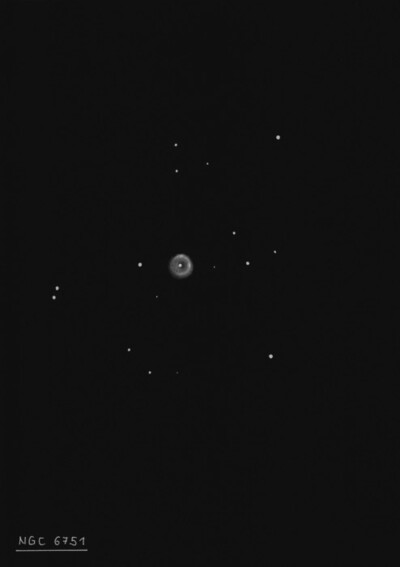
Albert Marth discovered NGC 6751 = m 397 = St XII-90 on 20 Jul 1863 using Lassell's 48-inch equatorial reflector on Malta and noted "pB, S." His position is 2' too far south. Édouard Stephan found it on 17 Jul 1871 and logged St II-26 (later NGC 6748) as "bright, small, round, central condensation, seems resolvable." He misidentified his reference star, though, and NGC 6748 was lost onto 2016 when Harold Corwin noticed the offsets for an observation of NGC 6751 given in Esmiol's re-reduction matched Stephan's computed offsets for NGC 6748. So, NGC 6748 = NGC 6751. Stephan made a second observation (St XII-90) of NGC 6751 on 3 Aug 1881 and measured an accurate micrometric position. In the notes section to list XII, he mentions a 2' error in Marth's polar distance, so he was aware of the prior discovery. Williamina Fleming first recognized it as a planetary nebula in 1907.
Based on Crossley photographs at Lick, Curtis (1918) reported "central star about mag 12. The nebular disk is 21" in diameter, nearly round, and shows indistinct evidences of a very irregular ring formation."
300/350mm - 13.1" (8/16/81): fairly faint, small, round. The mag 15 central star is suspected at high power. A mag 13.5 star is right at the east edge and a mag 12.5 is 55" ESE of center. Located 30' SE of the striking deep red variable V Aquilae (6.6-8.4).
400/500mm - 17.5" (6/3/00): fairly faint, small, round, 20" diameter. At 500x, the surface brightness is uneven and the planetary appears darker on the SE side of the center. The mag 14.5 central star is obvious at 500x. Two stars just off the east and west edge (fainter star is at the preceding side) bracket the planetary. Situated in a rich Milky Way star field.
600/800mm - 24" (9/30/16): symmetric, very attractive planetary at 450x (unfiltered). The edge of the 20" rim is crisply defined. The mag 14.5 central star is easily visible. Annularity is evident with a brighter rim except for a section of the south edge. The center is slightly darker around the central star. In a rich star field with carbon star V Aql 30' NW.
Notes by Steve Gottlieb